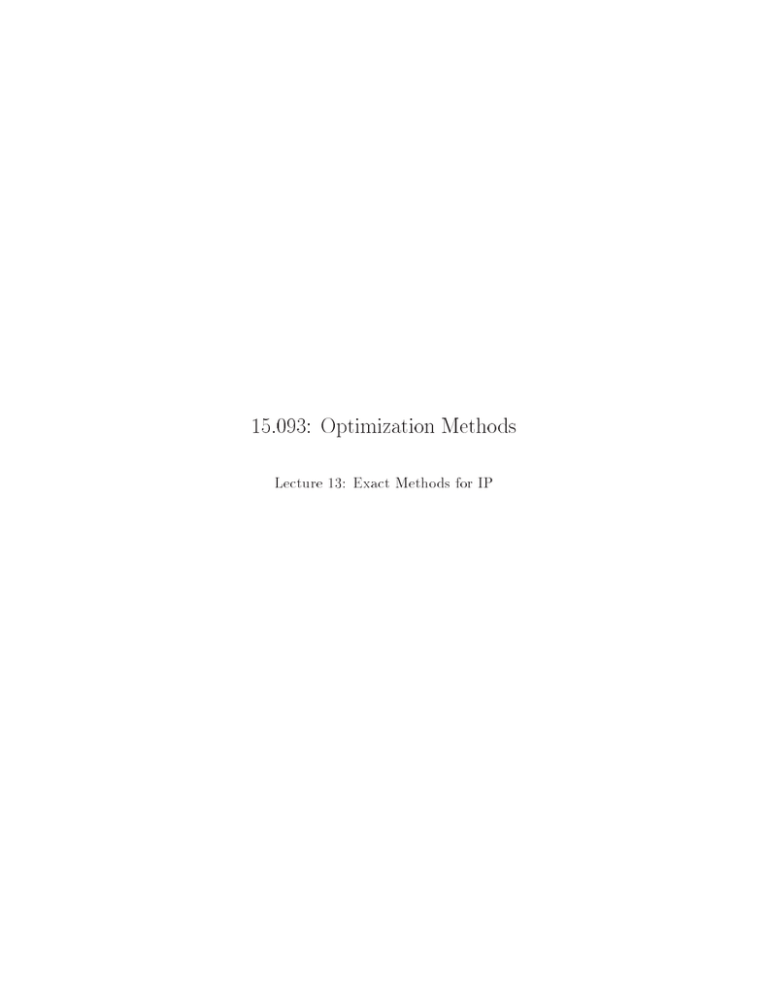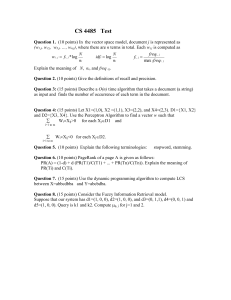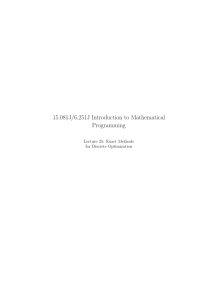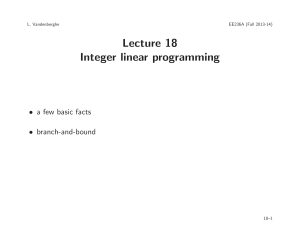Document 13449674
advertisement

15.093: Optimization Methods
Lecture 13: Exact Methods for IP
1 Outline
Slide 1
� Cutting plane methods
� Branch and bound methods
2 Cutting plane methods
min
s:t:
Slide 2
c0x
Ax � b
x�0
x integer;
LP relaxation
min
s:t:
c0x
Ax � b
x � 0:
2.1 Algorithm
� Solve the LP relaxation. Let x� be an optimal solution.
� If x� is integer stop; x� is an optimal solution to IP.
� If not, add a linear inequality constraint to LP relaxation that all integer
Slide 3
solutions satisfy, but x� does not; go to Step 1.
2.2 Example
� Let x� be an optimal BFS to LP ralxation with at least one fractional
Slide 4
basic variable.
� N : set of indices of the nonbasic variables.
� Is this a valid cut�
X
xj � 1:
j 2N
2.3 The Gomory cutting
plane algorithm
� Let x� be an optimal BFS and B an optimal basis.
�
xB + B�1AN xN � B�1b:
�
�
�
�
� aij � B �1Aj i , ai0 � B �1b i :
1
Slide 5
�
xi +
X
j 2N
aij xj � ai0 :
� Since xj � 0 for all j ,
X
X
xi + baij cxj � xi + aij xj � ai0 :
j 2N
j 2N
� Since xj integer,
� Valid cut
xi +
X
j 2N
baij cxj � bai0 c:
2.4 Example
min
x1 � 2x2
s:t: �4x1 + 6x2 � 9
x 1 + x2 � 4
x1 ; x2 � 0
x1 ; x2 integer:
We transform the problem in standard form
min
x1 � 2x2
s:t: �4x1 + 6x2 + x3
�9
x1 + x2
+ x4 � 4
x1 ; : : :; x4 � 0
x1 ; : : :; x4 integer.
LP relaxation: x1 � (15�10; 25�10).
�
� Gomory cut
Slide 6
Slide 7
1 x � 25 :
x2 + 101 x3 + 10
4
10
x2 � 2:
� Add constraints x2 + x5 � 2, x5 � 0
� New optimal x2 � (3�4; 2):
� One of the equations in the optimal tableau is
x1 � 14 x3 + 64 x5 � 43 :
� New Gomory cut
x1 � x3 + x5 � 0;
� New optimal solution is x3 � (1; 2):
2
Slide 8
x2
3
.
x1
..
- 3x1 + 5x 2 < 7
x2
2
x3
x2 < 2
1
0
1
2
3
4
x1
3 Branch and bound
1.
2.
3.
4.
5.
Branching: Select an active subproblem
Pruning: If the subproblem is infeasible, delete it.
Bounding: Otherwise, compute a lower bound ( ) for the subproblem.
Pruning: If ( ) � , the current best upperbound, delete the subproblem.
Partitioning: If ( ) , either obtain an optimal solution to the subproblem
Slide 9
Fi
b Fi
b Fi
U
b Fi
� U
(stop), or break the corresponding problem into further subproblems, which are
added to the list of active subproblem.
3.1 LP Based
� Compute the lower bound b(F ) by solving the LP relaxation of the discrete
Slide 10
optimization problem.
� From the LP solution x� , if there is a component x�
i which is fractional,
we create two subproblems by adding either one of the constraints
xi � bx�i c; or xi � dx�
i e:
Note that both constraints are violated by x� .
� If there are more than 2 fractional components, we use selection rules like
maximum infeasibility etc. to determine the inequalities to be added to
the problem
� Select the active subproblem using either depth-�rst or breadth-�rst search
strategies.
3.2 Example
max 12x1 + 8x2 + 7x3 + 6x4
s:t: 8x1 + 6x2 + 5x3 + 4x4 � 15
x1; x2; x3; x4 are binary:
3
Slide 11
Objective value=22.2
x1=1, x2=0, x3=0.6, x4=1
x3=1
x3=0
Objective value=22
Objective value=22
x1=1, x2=0.5, x3=0, x4=1
x1=1, x2=0, x3=1, x4=0.5
Objective value=22.2
x1=1, x2=0, x3=0.6, x4=1
x3=1
x3=0
Objective value=22
Objective value=22
x1=1, x2=0.5, x3=0, x4=1
x1=1, x2=0, x3=1, x4=0.5
x4=1
x4=0
Objective value=21.66
Objective value=22
x1=1, x2=0.33, x3=1, x4=0
x1=0.75, x2=0, x3=1, x4=1
LP relaxation
Slide 12
max 12x1 + 8x2 + 7x3 + 6x4
s:t: 8x1 + 6x2 + 5x3 + 4x4 � 15
x1 � 1; x2 � 1; x3 � 1; x4 � 1
x1 ; x2; x3; x4 � 0
LP solution: x1 � 1; x2 � 0; x3 � 0:6; x4 � 1 Pro�t�22:2
3.2.1 Branch and bound tree
3.3 Pigeonhole Problem
� There are n + 1 pigeons with n holes. We want to place the pigeons in the
holes in such a way that no two pigeons go into the same hole.
� Let xij � 1 if pigeon i goes into hole j , 0 otherwise.
�
Formulation 1:
P
� 1; i � 1; : : : ; n + 1
xij + xkj � 1; 8j; i 6� k
j
xij
4
Slide
Slide
Slide
Slide
13
14
15
16
Slide 17
Objective value=22.2
x1=1, x2=0, x3=0.6, x4=1
x3=1
x3=0
Objective value=22
Objective value=22
x1=1, x2=0.5, x3=0, x4=1
x1=1, x2=0, x3=1, x4=0.5
x4=1
x4=0
Objective value=21.66
Objective value=22
x1=1, x2=0.33, x3=1, x4=0
x1=0.75, x2=0, x3=1, x4=1
x1=1
x1=0
Objective value=21
Infeasible
x1=0, x2=1, x3=1, x4=1
�
Formulation 2:
P
� 1; : : : ; n + 1
xij � 1; 8j
i�1
Which formulation is better for the problem�
j
xij
� 1;
Pn+1
i
Slide 18
� The pigeonhole problem is infeasible.
� For Formulation 1, feasible solution xij � n1 for all i; j . O(n3) constraints.
Nearly complete enumeration is needed for LP-based BB, since the prob
lem remains feasible after �xing many variables.
� Formulation 2 Infeasible. O(n) constraints.
� Mesage: Formulation of the problem is important!
3.4 Preprocessing
�
�
�
An e�ective way of improving integer programming formulations prior to and
during branch-and-bound.
Logical Tests
{ Removal of empty (all zeros) rows and columns;
{ Removal of rows dominated by multiples of other rows;
{ strengthening the bounds within rows by comparing individual variables
and coe�cients to the right-hand-side.
{ Additional strengthening may be possible for integral variables using round
ing.
Probing : Setting temporarily a 0-1 variable to 0 or 1 and redo the logical
tests. Force logical connection between variables. For example, if 5x + 4y + z �
8; x; y; z 2 f0; 1g, then by setting x � 1, we obtain y � 0. This leads to an
inequality x + y � 1.
5
Slide 19
1
2
4
3
5
7
6
4 Application
4.1 Directed TSP
4.1.1 Assignment Lower Bound
Given a directed graph G � (N; A) with n nodes, and a cost cij for every arc,
�nd a tour (a directed cycle that visits all nodes) of minimum cost.
min
s.t. :
Pn
Pn
�1
Slide 20
Pn
i
j
�1 cij xij
� 1; j � 1; : : : ; n;
Pin�1
x
� 1; i � 1; :::; n;
j �1 ij
xij 2 f0; 1g:
xij
Branching:Set one of the arcs selected in the optimal solution to zero. i.e., add
Slide 21
constraints of the type \xij � 0" to exclude the current optimal solution.
4.2 Improving BB
�
�
�
�
�
Better LP solver
Use problem structure to derive better branching strategy
Better choice of lower bound b(F ) - better relaxation
Better choice of upper bound U - heuristic to get good solution
KEY: Start pruning the search tree as early as possible
6
Slide 22
MIT OpenCourseWare
http://ocw.mit.edu
15.093J / 6.255J Optimization Methods
Fall 2009
For information about citing these materials or our Terms of Use, visit: http://ocw.mit.edu/terms.
-
1





